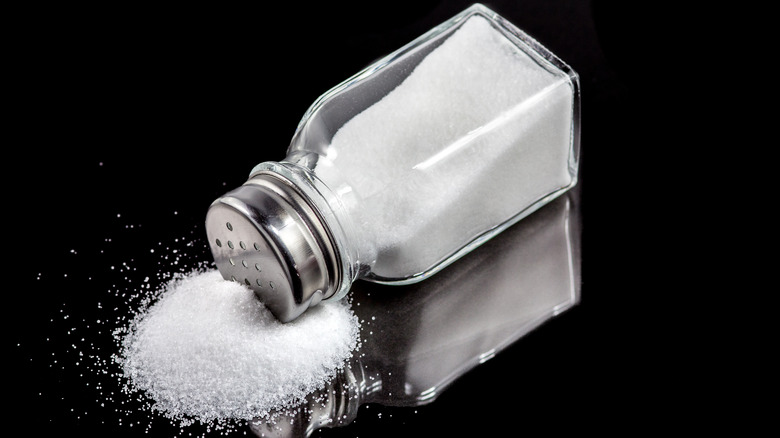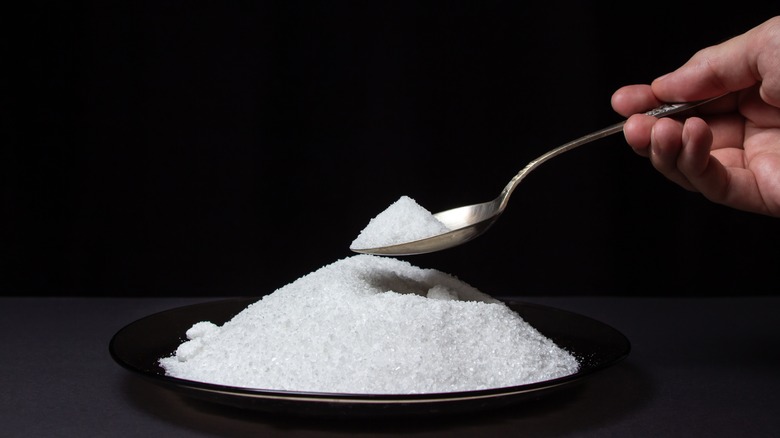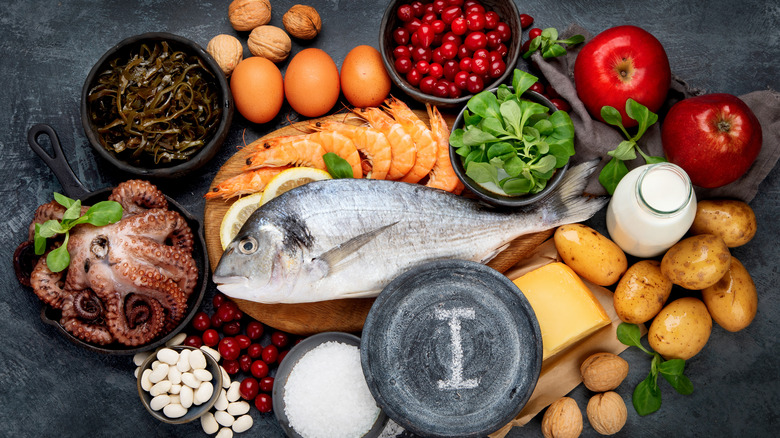Iodine Prevents Salt From Lasting Longer, But You Still Need It. Here's Why
Table salt needs no introduction — the Morton girl is a member of everyone's family — but if you're a fan of cooking shows, you may have noticed that professional chefs almost never use the stuff. Instead, the pros prefer using kosher salt (unless they're a TikTok chef, in which case they use flaky salt to dramatically finish off a dish that "anyone can make" as long as they have a dehydrator, a freeze-dryer, and $3,000 worth of wagyu beef). The main benefit of kosher salt is that it's less intense than table salt, and its grains are larger so each pinch contains less. This really helps to avoid oversalting your food.
Kosher salt is also purer than table salt because it is straight sodium chloride. Table salt typically contains anti-caking agents and iodide, the naturally-occurring form of iodine. In its pure form, salt has no expiration date, but iodine degrades over time, limiting table salt's shelf life to around five years. Down on all counts, table salt seems unworthy of its ubiquitous role in our lives. It seems like kosher salt should rule the kitchen. But if you grab a box of kosher salt at the store, you might be disturbed by these words on its label: "This salt does not supply iodide, a necessary nutrient." Reading that, it seems like switching to kosher salt might be risky. To figure out if that's true, we need to know why iodide/iodine is so important in the first place.
Why we need iodine
One of the more frustrating aspects of human biology is the fact that our bodies need iodine, but cannot produce it. Iodine is essential for the production of thyroid hormones, which regulate your metabolism. An iodine deficiency can disrupt growth and development, potentially causing cognitive impairments. Insufficient thyroid hormones lead to hypothyroidism, which can cause heart problems, nerve damage, and goiters (when the thyroid gland enlarges). It is especially dangerous for pregnant women, whose children can end up with birth defects. In fact, iodine deficiency is the leading preventable cause of developmental disabilities.
Scientists have used iodine to treat goiters since the mid-1800s, but iodizing salt did not become a common practice until the 1920s. Prior to that, hypothyroidism was an epidemic in many places. A strip of the northern United States, stretching all the way from the Northwest to the Appalachian Mountains, used to be called the "goiter belt" because a shocking 26%-70% of the region's children developed goiters. A series of pediatric studies conducted in the early 20th century shone a light on the problem and raised support for iodized salt, which was first introduced in the Great Lakes region (the heart of the goiter belt) to great effect (per Nutrients). Now iodized salt is available in most parts of the world, and it's used in 66% of global households, according to The New York Times. And yet ... you don't necessarily need it.
You don't need iodized salt to get iodine
Iodine is naturally present in a number of foods, and a well-rounded diet should be able to meet your needs. While iodine is essential, a little goes a long way, and the average adult should supplement no more than 150 micrograms daily. In the natural world, iodine can be found in the sea and soil, and in the flesh of many animals. Fish and shellfish are good sources, particularly tuna, cod, shrimp, and oysters. Leaner fish are better, and a very lean codfish can provide as much as two-thirds of your daily iodine requirements. One of the main sources of iodine in the American diet is dairy; the iodine in milk is passed along from animal feed and disinfectants used in milking that contain iodine.
There are also vegetarian sources of iodine. In fact, the very best natural source is probably seaweed. A single gram of kombu kelp can provide as much as 2,000% of your daily requirement. It's also available in some beans, particularly lima beans, and certain fruits, particularly prunes. Fortified breads and cereals are another source of iodine, though not as abundantly as the other foods mentioned here. Your risk of iodine deficiency is dependent on your diet and if you live in an area where the soil is low in iodine, which is typically inland mountainous regions. Taking these factors into consideration, you may find that you need iodized salt or that your options are more open.


